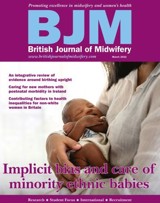References
Stand and deliver: an integrative review of the evidence around birthing upright

Abstract
Background
The benefits of upright birth positions are well-established in the literature, yet women are persistently challenged to assume the lithotomy or supine birth positions. This study aimed to explore what is known about women's capacity to assume upright birth positions in hospital environments, and its effect on physiological birth.
Methods
A structured five-step approach was employed to conduct an integrative review of the literature. The Cumulative Index to Nursing and Allied Health Literature and MEDLINE were searched for articles on women's position during labour and birth in hospital settings. Four articles were selected for inclusion and subjected to thematic analysis to elicit themes and subthemes.
Results
Three core themes emerged from this review: ‘the biomedical model of care and workplace culture impact the positions women adopt during labour and birth’, ‘midwives' philosophy and views support physiological birth’ and ‘clinical settings are not conducive to physiological birth’.
Conclusions
Midwives are losing the skills and confidence to support women into upright birth positions. Improved education and training around upright birthing may see a rise in women adopting these positions in hospital environments.
A woman's physiological instinct to assume upright positions during labour and birth is increasingly challenged in hospital settings, despite recommendations from the World Health Organization (2018) that women should have the autonomy to adopt any position deemed safe and comfortable during birth. Acknowledged as an evidence-based practice, adopting upright birth positions is known to positively impact maternal and fetal birth outcomes (Deliktas and Kukulu, 2018; Huang et al, 2019), yet labouring women are often encouraged into supine or semi-recumbent positions, which are known to increase the likelihood of epidurals and obstetric intervention (Gizzo et al, 2014). While medical intervention is acknowledged to be beneficial at times, the risk of these becoming routine practices has undoubtedly influenced the normal processes of birth (Gizzo et al, 2014; Lee and Tracy, 2019). Arguably, the rise in perineal trauma, prolonged labours (Huang et al, 2019) and increased rates of assisted birth worldwide (Atsali and Russel, 2018) are evidence that medical intervention during labour and birth are increasingly common practices.
Register now to continue reading
Thank you for visiting British Journal of Midwifery and reading some of our peer-reviewed resources for midwives. To read more, please register today. You’ll enjoy the following great benefits:
What's included
-
Limited access to our clinical or professional articles
-
New content and clinical newsletter updates each month

